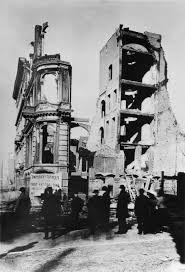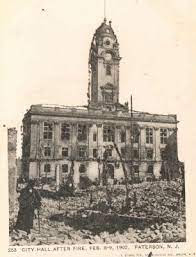“When A City Burns - Story of Paterson’s Biggest Fire”
“When A City Burns - Story of Paterson’s Biggest Fire” - Filbert Rosenstein's “Memoir” from an article in The Paterson Evening News February 13, 1952
For the more than 90,000 inhabitants of Paterson on that day, Saturday, February 8, 1902, had little to distinguish it from any other winter Saturday. The day was cold and windy, but not unseasonably so. At the Garden Theatre, “Jesse James” was playing and for the following night, the original “Seven -galas” {mental telepathists} was announced as a special feature brought at “enormous expense,” and the public was admonished, “If you can’t laugh, don’t come.” That night, “Paul Jones” was playing at the Opera House. Their presentations constituted one of Paterson’s social highlights each year.
And then, suddenly, calamity struck shortly after midnight. The car barns on Broadway below Main Street were afire. Soon, horse-drawn fire engines were clattering through the streets to do battle. But the flames had a powerful ally on their side – a high wind was blowing at 40 miles an hour. Sparks from the car barns alighted on adjoining houses on Broadway and Van Houten Street and then on Main, until the entire block was a mass of flames. A second alarm went in, and then a general alarm brought out every piece of fire fighting equipment in the city.
Sparks from the Main Street fire were blown over to the First Baptist Church on Washington and Van Houten and that church became a seething furnace. In no time, flames were devouring Broadway from Main Street to Church, while Main Street from Broadway to Market Street became an inferno as the stiff winds carried flames from the westerly side clear across the roadway to the easterly side.
It was an awesome and fearful night. Daylight brought no cessation. Between 9 and 6 o’clock, the wind, which had died down, took on new life. Fire broke out east of the Erie tracks and Park Avenue to Carroll Street and the Sandy Hill section became the scene of a “second conflagration but very little less in dimensions” than the one downtown. Here the destruction was mainly of homes and hundreds of families were driven into the streets in the bitter cold. Many had apprehended the danger and had placed their belongings on carts and wagons which they kept in front of their homes. Then, when the fire did come, the time was short to remove them a second time.
To help the Paterson Fire department, Passaic, Ridgewood, Montclair, Jersey City, Rutherford, Newark, and Clifton each sent one or two fire engines. However, the fire was burning in too many places to wage anything but a guerrilla action against it. Mayor Hinchliffe and Sheriff Sturr issued a joint proclamation forbidding anyone to be within the burned district after 7 o’clock at night without a pass from the mayor or the chief of police. Four companies of the National Guard were ordered to Paterson where they did patrol duty until 6 o’clock the following Thursday morning.
The damage was in excess of $10,000,000. From the point where the fire started to the place that it stopped the scene of destruction was almost a mile in length and the widest portion of any part of that area was almost half a mile. More than 25 blocks in the heart of the city were destroyed. On the day after the fire, Paterson was a city stricken but not crushed. Collections of money, clothing, and household articles were immediately begun. Within a week, over $25,000 was raised. Offers came from other cities, but were gratefully declined. “Paterson takes care of its own.” The city offices were soon temporarily transferred. Every bank was open for business. Within a few days, the merchants and professional men were announcing new temporary quarters.
Because the Second Presbyterian Church had become consumed in the fire, Barnert Memorial Temple offered the facilities of its building without charge to the congregation. .Within hours, the offer was accepted. For nearly three years, the Presbyterian congregation worshipped on Sundays at the Barnert Temple building on Broadway, an arrangement described in an article as “an unprecedented occurrence, but serving to show the breadth and depth of religious life in this city.” Both congregations displayed a sublime spirit. The two congregations were fortunate in having leaders to whom religion was greater than dogma. When Rabbi Abram Isaacs made the suggestion for the arrangement, the lay leader Nathan Barnert enthusiastically seconded it. When the offer was made, Reverend Charles Shaw and his lay leaders Gen Joseph Congdon and W.O. Fayerweather accepted with equal enthusiasm. It was truly a demonstration of brotherhood –“Love thy neighbor as thyself.”
Filbert Rosenstein

Photo of 1902 devastating fire

Another image of the destruction of the 1902 fire.
